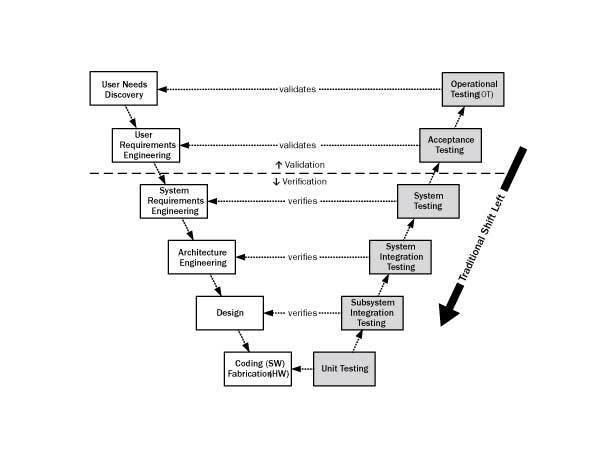 | ||
Shift left testing is an approach to software testing and system testing in which testing is performed earlier in the lifecycle (i.e., moved left on the project timeline). It is the first half of the maxim "Test early and often."
Contents
Harm Due to Late Testing
Shift left testing is important because it helps to prevent the following types of harm due to late testing:
Types of Shift Left Testing
There are four basic ways to shift testing earlier in the lifecycle (that is, leftward on the classic V-model). These can be referred to as traditional shift left testing, incremental shift left testing, Agile/DevOps shift left testing, and model-based shift left testing.
Traditional Shift Left Testing
As illustrated in the following figure, traditional shift left moves the emphasis of testing lower down (and therefore slightly to the left) on the right hand side of the classic V model. Instead of emphasizing acceptance and system level testing (e.g., GUI testing with record and playback tools), traditional shift left concentrates on unit testing and integration testing (e.g., using API testing and modern test tools). The transition to traditional shift left testing has largely been completed.
Incremental Shift Left Testing
As illustrated in the following figure, many projects developing large and complex software-reliant systems decompose development into a small number of increments (Vs) having correspondingly shorter durations. The shift left illustrated by the dashed red arrows occurs because parts of the single, large waterfall V model’s types of testing (shown in gray) are shifted left to become increments of the corresponding types of testing in the smaller incremental V models. When each increment is also a delivery to the customer and operations, then incremental shift left testing shifts both developmental testing and operational testing to the left. Incremental shift left testing is popular when developing large, complex systems, especially those incorporating significant amounts of hardware. Like traditional shift left, the transition to incremental shift left has also been largely completed.
Agile/DevOps Shift Left Testing
As illustrated in the following figure, Agile and DevOps projects have numerous short duration Vs (a.k.a., sprints) in lieu of a single or small number of V as in the previous two examples of shift left testing. These small Vs would also be modified if one or more early sprints are used to block out the basic requirements and architecture or if test-first and test-driven development (TDD) are being performed. The shift left occurs because the types of testing on the right sides of the earliest of these tiny Vs are to the left of the corresponding types of testing on right side of the larger V(s) they replace. While the following figure appears remarkably the same for Agile and DevOps, Agile testing is typically restricted to developmental testing and does not include operational testing, which occurs once the system is placed into operation. The transition to Agile/DevOps shift left testing is currently popular and ongoing.
Model-Based Shift Left Testing
The previous forms of shifting testing left all concentrated on beginning the testing of software earlier in the development cycle. Waiting until software exists to begin testing, however, largely and unnecessarily limits the use of testing to uncovering coding defects. This delay is particularly disturbing because from 45 percent to 65 percent of defects are introduced in the requirements, architecture, and design activities.
As illustrated in the following figure, model testing moves testing to the left side of the Vs by testing executable requirements, architecture, and design models. This shift enables testing to begin almost immediately, instead of waiting a long time (traditional), medium time (incremental), or a short time (Agile/DevOps) until software on the right side of the Vs is available to test. This trend is just beginning.
